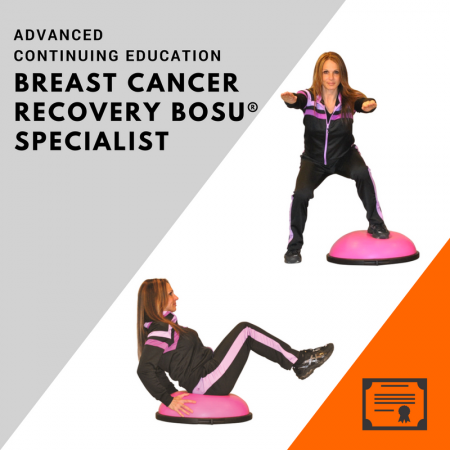Personal trainers working primarily with general fitness clients are usually pumped when signing an advanced client, or when a current client is ready to raise the bar. It’s an opportunity to apply our knowledge in a different way, get creative with the workout, and introduce more dynamic exercises.
“Advanced” clients are those that are wanting to work for more than general fitness; they are ambitious and want to gain more than functional strength. They look forward to agility drills, welcome mobility work, aren’t afraid of a challenge, and have developed elevated body awareness.
These types of clients already have a solid fitness foundation and may crave more than traditional exercises to reach their goals. This is why they are such fun clients to have! They pose a challenge to the trainer’s creativity, necessitating dynamic and multi-planar movements.
Elements of Advanced Exercise
When a client is at this level, you can manipulate more than just the amount of weight they’re moving around. An exercise can become significantly harder without the weight ever-changing by altering other key components.
Four Main Elements:
- Surface the exercise is being performed on
- The mode of resistance (weight) that is being used (Free weights vs machine resistance, for instance)
- Bilateral vs unilateral motion
- The speed at which the exercise is being executed
Surface of the Exercise
Altering the surface of the exercise will change the recruitment of stabilizers. An unstable surface will require more than just the prime movers than a stable surface. Here are some of my favorite options:
BOSU Squat Jump Up-and-Over:
This will challenge agility, balance and power. It’s a great exercise when time efficiency is a priority. It’s best for the client who is already comfortable and competent working with an unstable surface (doing squats on the BOSU should be mastered, for instance).
It improves the strength and stability of ankles and knees. It is ultimately a squat jump with an added element.
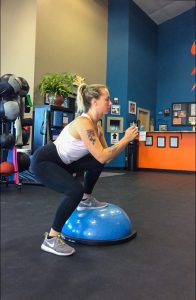
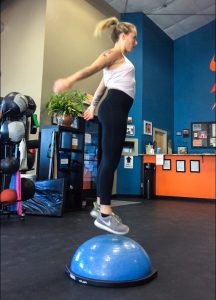
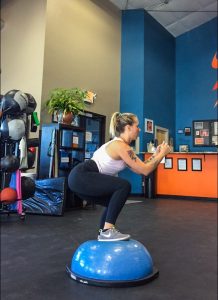 – Start with BOSU with round surface facing up
– Start with BOSU with round surface facing up
– One foot on the ground, one foot on the center of the BOSU
– Start in a deep squat position and then jump up and over to the other side
– Land with the foot that was previously on the ground now on top of the BOSU and the other foot on the ground and in a deep squat.
BOSU Squat:
I find it’s easiest for the client to get on and off the BOSU when holding the resistance in front of them. However, you can increase intensity by making it a back squat, just be sure to spot.
– Start with BOSU flat surface facing up
– Stand on top of BOSU with weight in hand
-Take a deep squat, taking care to maintain control and balance
– Weight can also be supported on shoulders using a bar
Stability Ball Bicycle Crunch
One of my favorite abdominal exercises, but not one I employ often considering its significant difficulty. It’s a potent movement that demands stability and control.
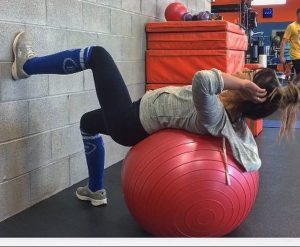
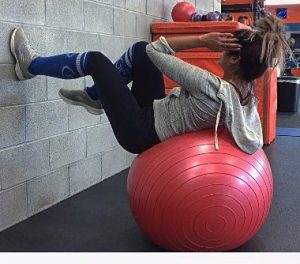 – Begin sitting upright on the stability ball about two feet from the wall.
– Begin sitting upright on the stability ball about two feet from the wall.
– Walk the feet towards the wall, tucking the pelvis under into a reclining position. The low back is supported by the ball, but the shoulder blades/upper back are elevated from the ball.
– Place one foot on the wall, the other on the ground.
-Inhale and extend the spine back, while the low and pelvis back maintain contact with the ball. (These contact points are maintained for the entire exercise. The pelvis will want to do a see-saw motion and also lift up when the client arches back; discourage this to attain greatest efficacy)
– Exhale as while crunching up and twisting while the leg on the ground lifts, meeting elbow to opposite knee.
Mode of Resistance and Unilateral vs. Bilateral
It’s not always a question of how much weight is being moved, rather than what kind of weight is being moved. I’ve seen beefy dudes utterly wrecked from appropriately executed resistance band exercises. Using different modes of resistance will improve coordination, balance and body awareness. Also, keeping a variety in the mode of resistance means the movement isn’t as predictable. The human body has to work harder when it doesn’t know what to expect.
When an exercise is unilateral compared to bilateral, it will require a lot more stabilizing and coordination to keep the body in proper alignment. The weight distribution isn’t even, so the body is imbalanced. The challenge of a unilateral exercise is maintaining the body’s balance and posture regardless of where the external weight is being held. I often pair these two manipulations into one exercise.
It is also important to consider if the exercise is a compound movement or single joint.
Unilateral Kettle Bell DeadLift to Shoulder Press
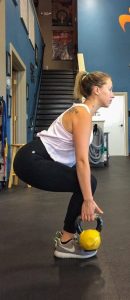

-Start holding the weight in one hand, maintain square pelvis and shoulders, keeping an even distribution of body weight between the two sides. (Using a kettlebell instead of a dumbbell puts the weight’s center of gravity slightly behind the shoulder in the press. This will require more stabilizing of the shoulder joint.)
– Initiate deadlift by hinging at hips and keeping knees bent.
– Return to standing and pull the kettlebell to shoulder height.
– Once fully stable, push kettlebell overhead.
Speed of Exercise
When altering the speed of an exercise I usually slow it down so the working muscles are under load longer. This stresses the muscle fibers without increasing weight and requires the client to be in better control of that weight.
I’m fond of applying this to the lat pulldown and the bench press. I often see clients trying to work through these as quickly as possible. When the exercise is slowed down, the client becomes more aware of how they are moving, their range of motion and the supporting musculature. I will instruct the client to move through both the eccentric and concentric motion for a count of 3-4 each.
These are only a few examples of the multiple ways these variations can be applied. Spend some time in your own workouts trying these techniques, and discover as many options as you like! Altering exercises beyond intensity only is where trainers get to have fun and create. It is an opportunity to explore the knowledge we have and invent more engaging and effective workouts.
In what ways have you challenged your advanced clients?
Alex has her A.S in Exercise Science and is a certified Personal Trainer with NFPT and NSCF. She recently traveled to India to gain her 200 hr yoga teacher certification where she studied the ancient practice at its origins. Alex has spent time teaching yoga in Spain while volunteering at a yoga retreat and is currently working at her local college instructing two fitness courses. Alex wants to share with her clients and students the mental, physical and emotionally healing qualities of exercise and movement. She believes everyone should have a healthy relationship with their bodies and strives to thread that concept throughout her career.

